Making clothes from Japanese Kimono
Japanese Kimono are one of the most traditional and emblematic clothes in the world of cultural fashion. Here the JOI Japanese language learning blog, introduces a practical method of how to repair and remake the Kimono into a blouse.
Yanaka sensei is Japanese teacher at JOI and she her hobby is dressmaking and Kimono make-overs. She explains in detail the process of this great Japanese craft.
You can learn Japanese here by listening to the video online and also reading the blog and learning the Kanji and Japanese vocabulary.
生まれ変わるきもの
Japanese Kimono reborn

By YANAKA Izumi
私の通っている着付教室には、和裁やリフォームのクラスがあります。そこでは、ときどき和裁やリフォームの体験講座が開催されます。9月はリフォームの講座があったので申し込みました。テーマは「着物から作るブラウス」です。
リフォームは古い着物や着なくなった着物をほどくところから始まります。私はいらない着物を持っていなかったので、古着屋で羽織を買ってそれをリフォームに使いました。
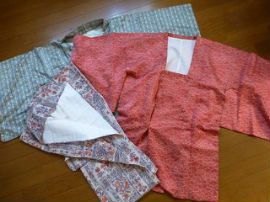
An old Haori coat and old Kimono.
着物はしっかり縫ってあって、ほどくのが大変でした。
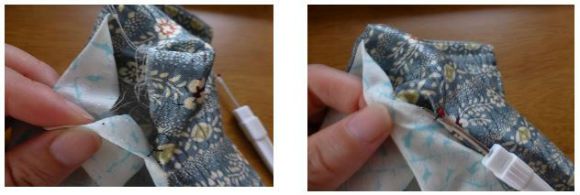
It is well-stitched. I unstitch the Kimono.
ほどいてみると、不思議なことにすべて長方形の布になりました。着物は幅34センチ、長さ12メートルの長い布を直線で切って作るそうです。だから、ほどいた布は店で買ってきた布のように長方形の布になるのです。
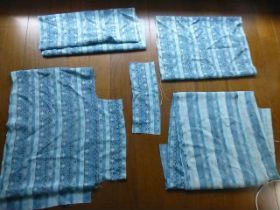
We unstitched the whole thing. The unstitched cloth is vaguely rectangular.
そのままだと幅が足りないので、布の柄を考えながら布を縫い合わせます(柄合わせ)。この柄を合わせるのがリフォームのおもしろいところでもあり、難しいところでもあります。布を縫い合わせた後は、型紙を置いてしるしをつけ、縫い代を取って裁断します。それから、裁断した布をミシンで縫って出来上がりです。
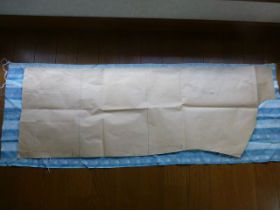
Place the pattern paper on top.
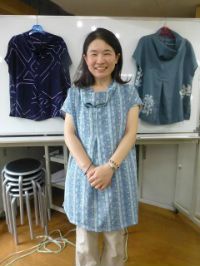
It is done.
いかがでしょうか。着物がブラウスに生まれ変わりました。他の生徒の皆さんの作品も見ましたが、同じ作り方なのに全然雰囲気が違ってとてもおもしろかったです。私はリフォームのおもしろさを知って、今、次の作品に取り掛かっています。しばらくは、たくさんブラウスができそうです。
To listen to this blog, please watch our Youtube video.
生(う)まれ変(か)わる着物(きもの)
私(わたし)の通(かよ)っている着付教室(きつけきょうしつ)には、和裁(わさい)やリフォームのクラスがあります。そこでは、ときどき和裁(わさい)やリフォームの体験講座(たいけんこうざ)が開催(かいさい)されます。9月(くがつ)はリフォームの講座(こうざ)があったので申(もう)し込(こ)みました。テーマは「着物(きもの)から作(つく)るブラウス」です。
リフォームは古(ふる)い着物(きもの)や着(き)なくなった着物(きもの)をほどくところから始(はじ)まります。私(わたし)はいらない着物(きもの)を持(も)っていなかったので、古着屋(ふるぎや)で羽織(はおり)を買(か)ってそれをリフォームに使(つか)いました。着物(きもの)はしっかり縫(ぬ)ってあって、ほどくのが大変(たいへん)でした。ほどいてみると、不思議(ふしぎ)なことにすべて長方形(ちょうほうけい)の布(ぬの)になりました。着物(きもの)は幅(はば)34センチ、長(なが)さ12メートルの長(なが)い布(ぬの)を直線(ちょくせん)で切(き)って作(つく)るそうです。だから、ほどいた布(ぬの)は店(みせ)で買(か)ってきた布(ぬの)のように長方形(ちょうほうけい)の布(ぬの)になるのです。
そのままだと幅(はば)が足(た)りないので、布(ぬの)の柄(がら)を考(かんが)えながら布(ぬの)を縫(ぬ)い合(あ)わせます(柄合(がらあ)わせ)。この柄(がら)を合(あ)わせるのがリフォームのおもしろいところでもあり、難(むずか)しいところでもあります。布(ぬの)を縫(ぬ)い合(あ)わせた後(あと)は、型紙(かたがみ)を置(お)いてしるしをつけ、縫(ぬ)い代(しろ)を取(と)って裁断(さいだん)します。それから、裁断(さいだん)した布(ぬの)をミシンで縫(ぬ)って出来上(できあ)がりです。
いかがでしょうか。着物(きもの)がブラウスに生(う)まれ変(か)わりました。他(ほか)の生徒(せいと)の皆(みな)さんの作品(さくひん)も見(み)ましたが、同(おな)じ作(つく)り方(かた)なのに全然(ぜんぜん)雰囲気(ふんいき)が違(ちが)ってとてもおもしろかったです。私(わたし)はリフォームのおもしろさを知(し)って、今(いま)、次(つぎ)の作品(さくひん)に取(と)り掛(か)かっています。しばらくは、たくさんブラウスができそうです。
Japanese Kimono reborn
There are some Japanese dressmaking and dress make-over classes at the Kimono classroom that I attend. And they sometimes open a trial lesson for Japanese dressmaking and dress make-overs. I applied to one of the make-over classes in September. The theme was making a blouse from Kimono material.
Make-overs start with taking apart old Kimono or Kimono that you no longer wear. I didn't have any unwanted Kimono myself, so I bought a Haori coat at a second-hand clothes store, and used that for the make-over class. The Kimono was really well-sewn together, so taking it apart was really difficult. After unstitching it, I found that curiously, all of the pieces of cloth were rectangular. Kimono are made by cutting a piece of cloth which is 34 centimeters wide and 12 meters long into straight lines. So the Kimono breaks down to rectangular pieces when unstitched just like the material you get when you buy it at the store.
However, the width was not enough as it was, so I while thinking of the pattern, I sewed it together with another piece of cloth. This matching of different patterns is one of things that makes dress make-overs so interesting, and also what makes it so interesting. After sewing the pieces together, you lay a pattern paper over the top, and make markings onto the cloth and add the margins to sew along and then cut into shape. And then you sew the cut pieces together with a sewing machine and then you're done .
What do think ? The Kimono has been reborn as a blouse. I looked at the other students' works and it was really interesting, even though we used the same method of making, the mood of each piece was completely different. Now that I have discovered the joys of dress remaking I am already getting to work on my next piece. It looks as though I am going to have a lot blouses in while.
生まれ変わる(うまれかわる) reborn;
着付教室(きつけきょうしつ) a kimono wearing class
和裁(わさい) Japanese dressmaking
リフォーム make over
体験講座(たいけんこうざ) trial lesson
開催(かいさい) open
申し込む(もうしこむ) apply;
ほどく undo [unsewn] a dress ; take a kimono apart
~から始(はじ)まる begin at ~
いらない no use; unwanted
古着屋(ふるぎや) an old-clothes store
羽織(はおり) a haori ( short coat for formal kimono)
しっかり tightly
不思議(ふしぎ)なことに Curiously;
長方形(ちょうほうけい) rectangle
布(ぬの) cloth
幅(はば) width
長さ(ながさ) length
直線(ちょくせん) straight line ;
足(た)りない be short
柄(がら) a pattern
縫い合わせる(ぬいあわせる) sew together
柄合わせ(がらあわせ) pattern fitting
型紙(かたがみ) a pattern paper
しるしをつける to put a mark on cloth
縫い代(ぬいしろ) a margin to sew up
裁断(さいだん) cutting
ミシン a sewing machine
作品(さくひん) a work
雰囲気(ふんいき) mood
取り掛かる(とりかかる) go to work